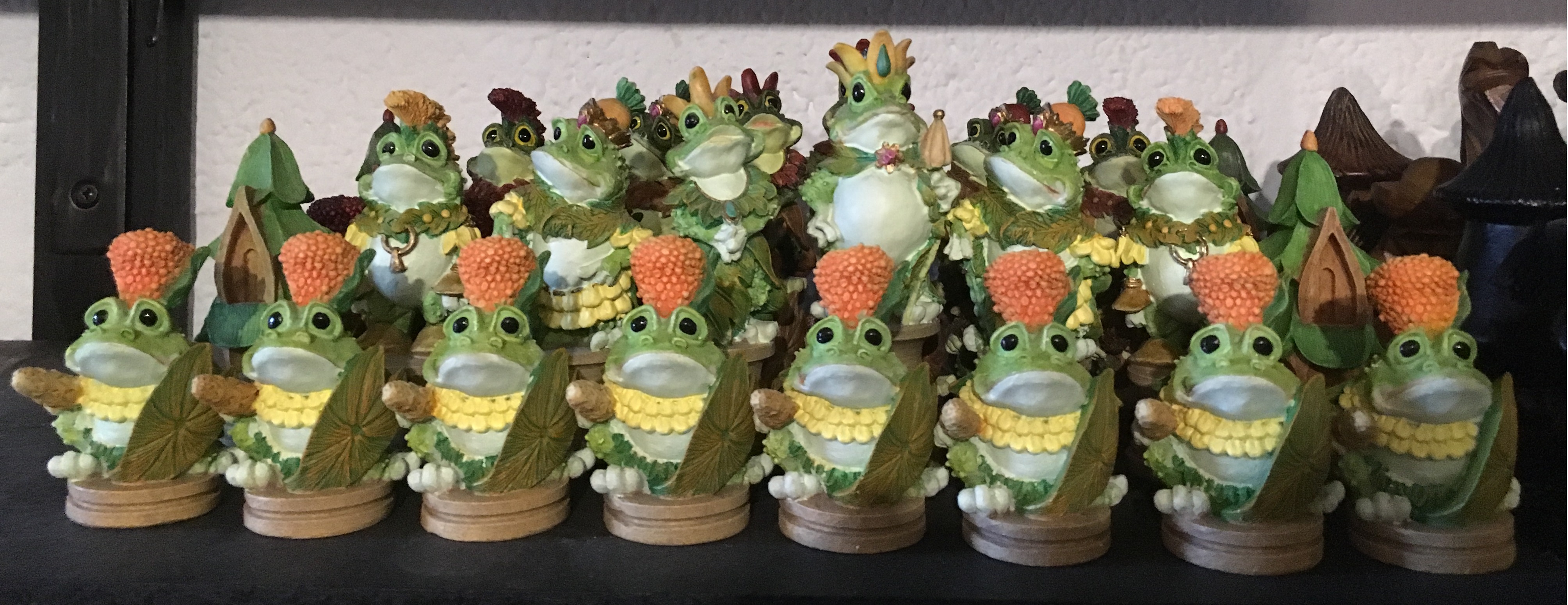December is here! It´s hard to avoid the Christmas songs, and the Christmas movies are being dusted off again, too. A ‘golden oldie’ is Rupert and the Frog song. The singing frogs from this animated film can be admired in the Chessmen Museum.
In the company of all the museum´s chess games, it is sometimes difficult for a chess piece to get noticed, but that is not a problem for the Frog Chess Game. The cheerful, green chess pieces from the Rademaker Collection almost literally leap out at you. They represent frogs from the song We all stand together by Paul McCartney. He took part in this song and produced the accompanying short animation film about the little bear called Rupert. The animation film was released 35 years ago and is now a true Christmas classic. The famous song of the croaking frog chorus is always played around Christmas as well.
Origin of Christmas carols
England has a long tradition of Christmas Carols. In the past, it was believed that these carols were already sung in the times of baby Jesus, around his manger, but that seems highly unlikely. It is true that the manger and the holy baby are often the main subject of the carols´ lyrics though; something Francis of Assisi (1182-1226) is responsible for. Saint Francis, the founder of a secular monastic order who was proclaimed saint in 1228, placed great emphasis on Jesus in the manger in order to make faith more appealing to ordinary people. His disciples, the Franciscans, also spread this image further through Christmas songs. They used existing folk songs for this and changed the lyrics into Latin hymns.
The oldest English Christmas carols date back to the twelfth century. They were originally dance songs that the English sang for Christianisation and danced to during the rituals of their mid-winter celebrations, when the longest night of the year made way for more daylight. With the advent of Christianity, these pagan folk songs got a Christian twist to them. Carols were not only sung and danced to during Christmas, but also on other occasions, both religious and less religious, such as weddings or even war victories. These dances were also performed in the courts, where court musicians adapted the folk texts of the songs to the taste of the aristocracy.
Unfortunately, we do not know which melodies they used, because no medieval sheet music has been preserved. Through oral tradition, we do know how a carol is schematically structured. A solo singer would sing four lines of four stresses and then the chorus. The choir would sing a repeating line about the theme of the song. The early carol performers were multifunctional: the same people had to both sing and dance and they would also play the accompanying instruments.
Popularity revival
After Christianisation, carols got a bad name. They were pagan expressions, forbidden by the church. But because of the Franciscans singing about baby Jesus in the manger to old melodies, carols became very popular again in England. The accompanying wild dance was toned down and was now performed in the stable, around the manger. Most carols from this period focused on Christmas and Epiphany, which is why we now associate carols with Christmas songs. However, there were also carols about Maria which were sung all year round. In addition, many saints had their own carol, which people sang on the saint’s name day. Carols even became so popular that in the 15th century they had largely repressed the official Gregorian songs.
The arrival of Protestantism in the 16th century meant the end of carols: they were again considered pagan expressions, just like in the early Middle Ages, and they disappeared from religious songbooks. In judicial litigation books about witch prosecutions from the 16th century, the singing of carols was often used for the accusation of witches. The ban on carols was lifted after 1660, but the songs were still considered evil, at least by the clergy. Among the people, the carol had indeed remained popular, especially during the Christmas period. The church was fighting a losing battle so it was decided that some carols could be sung again during mass.
Printed carols
The fact that we still know a lot of carol lyrics and music is because they were recorded by collectors in the 19th century and published in printed form. The singing of carols on the street and in church completely revived. The material underwent quite a change: new lyrics to medieval music or totally new carols were added to the repertoire. Many of the now familiar carols with their accompanying melodies stem from this period. The Anglican church included the songbooks in its liturgy and in doing so, carols were sung and spread throughout the world by Englishmen.
The most famous carol, Silent Night, Holy Night from 1818, is originally German. This song, translated into approximately 230 languages, is one of the big favourites everywhere, including England. To attend the most famous Christmas carol performance we have to go to a church, too: the chapel of King’s College in Cambridge. Here, the boys’ choir still sing like nightingales with their high voices. Nobody can match that, not even the frogs from the Rupert and the Frog song, but their song certainly gives you goose bumps.




You must be logged in to post a comment.